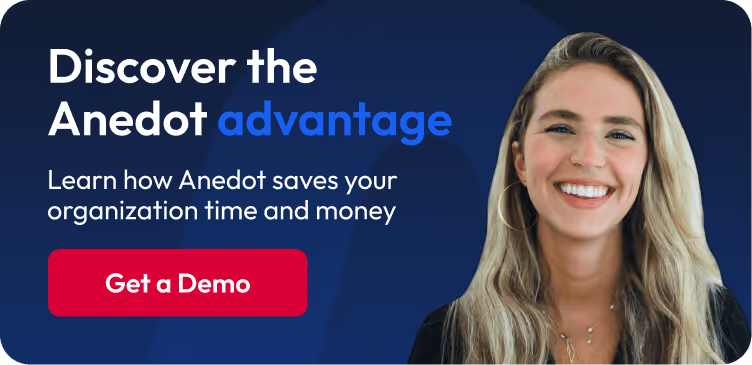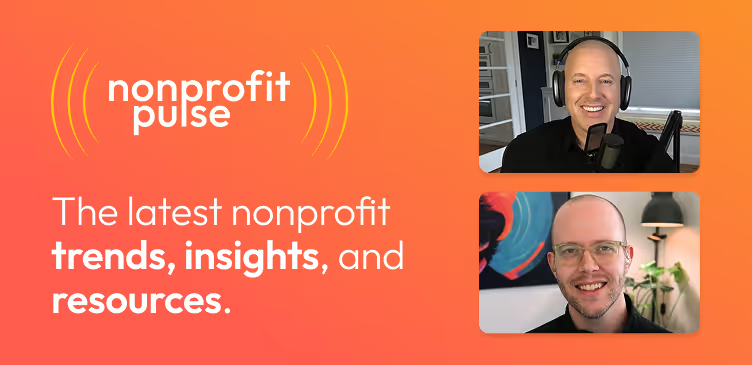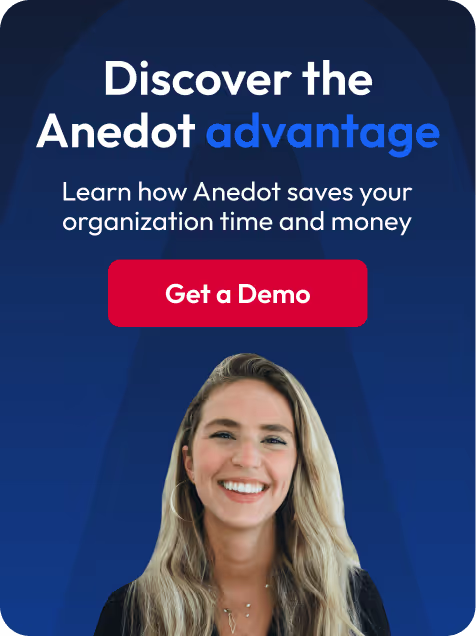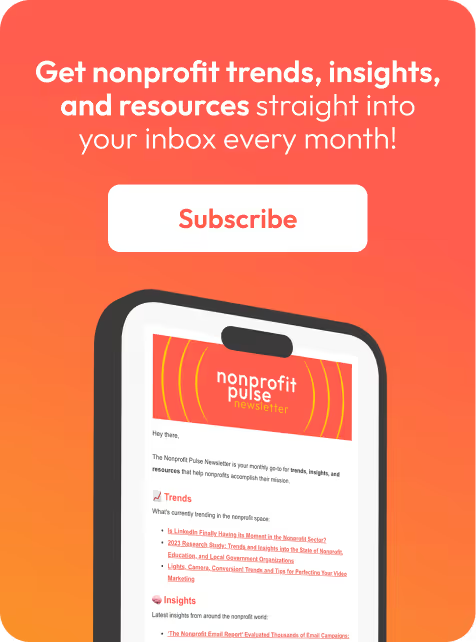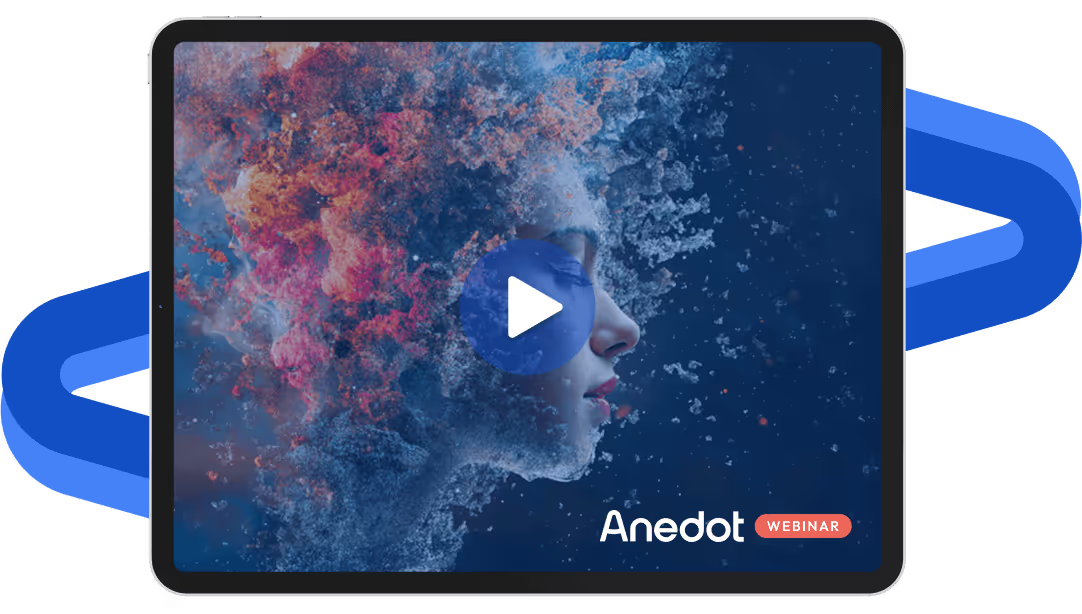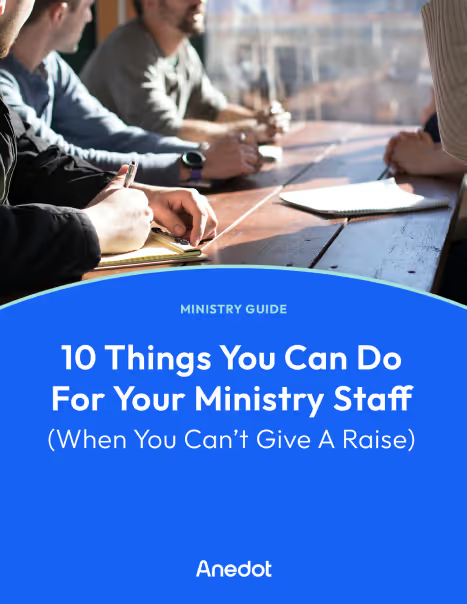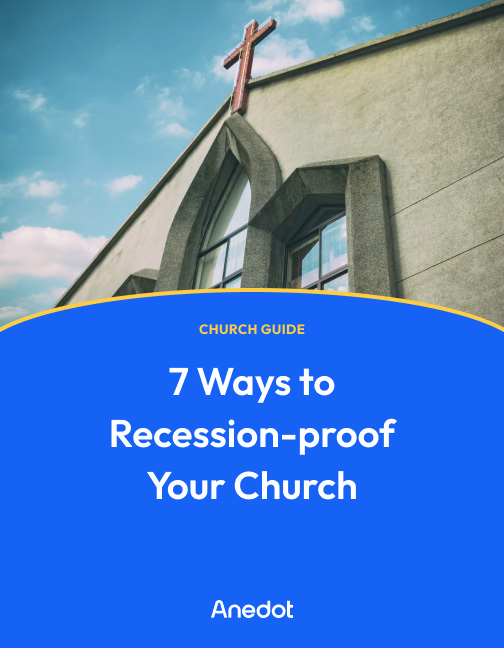Podcast episode transcript ↓
Josh:
Nonprofit leaders wear many hats and are often pulled in multiple directions.
This reality often leads to neglecting the donor experience.
However, your donor's experience will significantly help or hinder your nonprofit's ability to grow and fulfill its mission.
I'm Josh with Anedot and welcome to Nonprofit Pulse, where we explore trends, insights, and resources to help nonprofits accomplish their mission.
On this episode, we're joined by Mark Miller on the topic of donor experience. Mark is the co-founder and brand strategist at Historic Agency where he serves nonprofits and ministries.
Hey Mark, thanks for coming on the show.
Mark:
Thanks for having me.
Josh:
Hey, so today we're going to be talking about donor engagement and really more particularly brand-first donor engagement.
And I'm so pumped to talk through this with you. You've been doing a lot of great work at Historic on this topic.
What is brand-first donor experience?

Josh:
So maybe starting first, could you just define what is donor engagement and even brand-first donor engagement?
Mark:
Yeah, so donor engagement, just being how are we activating donors and how are they engaging with our content?
And whether it's financially or volunteering or all the different ways, we're seeing many more ways for people to participate, especially younger generations wanting to participate in engaging with nonprofits.
And brand-first donor experiences is kind of our internal language of being really strategic on how we communicate and engage donors so that they can recognize the brand that we represent, the brand that we want them to experience as a partner in our cause or our organization.
Josh:
Yeah. So talk to us how you're seeing this play out for nonprofits as y'all serve nonprofits.
What's really to lose here by not focusing on a robust donor engagement plan?
Mark:
Yeah. So the thing that we keep seeing, and there's lots of new research coming out about this, is that what's happening in general, is the, your top 10% of your donors are giving more money and the rest are kind of fading away.
So if you look at data, younger generations are less likely to engage at the same levels. That's always been the case.
But the thing that is really challenging is that the number of them engaging is dropping down.
And then if you look at the historical data of income in the United States, today's 30 year old makes half of what a 30 year old made I think 50 years ago.
And so when today's 30 year old becomes 60 or 70, there's a good chance that they're not going to be able to give at the same level that the previous generation did at that same age.
So there's this, I would say impending cliff, but this thing where donors have more choices now, people have more ways to engage in social impact and the causes that they care about, whether it's buying products that represent a cause and giving back, it's serving, it's giving.
There's a lot of different choices. And so we want to make sure that when we coach our nonprofits, our clients, that they're really focused on the brand that they're building so that there's an affinity to why I'm engaged and why I'm giving to this organization.
And with 1.5, 1.6 million nonprofits in the United States alone, there's a lot of noise and not a lot of clarity.
Josh:
So you mentioned the term brand and that means a lot of different things to different people and different organizations even in the nonprofit space.
What does brand mean? So can you unpack that for us? How does Historic Agency define brand?
Mark:
I think the simplest way to define brand is what other people say about you when you leave the room, it's a Jeff Bezos quote.
Because it's not your logo, it's not your website, the way people feel about your organization.
Now we take it a step further at Historic and say, it's not just what people say about you. That's basically how you experience the brand is what other people saying about you.
But the way you actually create it, again, it's less about logo and website. Those all play into it, but it's really about organizational culture because your organizational culture dictates what is a priority, what budgets get funded, who you hire, how you fire, what goes on the website, what products and services you offer.
Those are all heavily influenced by organizational culture. So those two things kind of go hand in hand.
And when we talk about donor engagement, you'll see how your organizational culture will usually bleed through good or bad to how the donor experiences the organization.
The "secret sauce" for better donor cultivation

Josh:
Got it.
So thinking through our audience, they're nonprofits right now, or nonprofit leaders who are listening, who they may not have a strong donor engagement plan in place, or maybe they have one that they feel is antiquated and they want to start afresh or lean into that in 2023.
Where's really the starting point for nonprofits to lean into donor engagement?
What's the first step?
Mark:
Well, when we talk about a brand-first donor experiences, we really want to look at all the communication and address the communication strategy first.
There's lots of different tactics, which I can get into the end of how to better engage donors. But generally it's any marketing or communication will highlight the things that are good or bad. It's like gasoline on a fire.
So if you don't have really great strategy and you don't have really great messaging and positioning and you are confused about your culture, what is really important, that will all come through, especially in major donor relationships in your email, both cadence and messaging and they ask all those things, social media, it all kind of bleeds through.
So it's really thinking through that strategy. And we have a kind of three part framework that I think will help donors or organizations of all sizes engage better with their donors, whether they're new or existing donors.
Josh:
So it really starts with an audit of what are you communicating, where and to whom, and then you go from there into what do you want to be communicating, what do you want people to be experiencing, who are coming to your organization through your website, through your social media, all of your channels.
And so talk us through what the next step is then after that.
Mark:
Yeah. So after an audit and kind of clarifying strategy, we call it the secret sauce.
And that is as you go through all your communication, you really want to make sure you're communicating these three different things in every donor touchpoint, whether it's a phone call, an email, a direct mail appeal, website, social.
Sometimes you can't communicate all three at the same time. Maybe it's too, or in social media, maybe it's like three consecutive posts, one for each topic. But these three things are your values.
So one of your organizational values, your differentiation. So this is how you stand out from others in your space. So if you're in clean water, what makes you different in clean water than others?
Maybe it's your approach to clean water as a solution to human trafficking. So there's a lot of data around that. So there could be that as your differentiation and then unfair advantage, that's going to be the thing that you do as an organization that others don't, like your methodology or your approach.
And that could be, for instance, we want to not just foster kids, but we want to help keep kids with their parents. And we have a specific way of getting support and education to the parents so at risk kids can stay with their families in instead of being sent off to foster care.
So unfair advantage, when you start to communicate all three of those things in every donor touchpoint, it becomes really clear to the donor what you're about. And so a couple examples here.
We had a organization that we were working with in the Middle East, which is a very volatile area of the world.
A lot of people have lots of opinions about it. So it's really hard for donors to really know what's going on here, why should I give and is there another crisis that I can give to?
And so one of their values was respect. And so we crafted a plan around making sure respect was in every way we communicated, it was respectful to the people that we serve, to the donors.
Every touchpoint was respectful to the audience that we're either serving or communicating about.
Second, the Middle East was kind of their differentiation.
They only focused in that region for relief and other things. And then they primarily used people on the ground.
So local partners, instead of sending a bunch of people there from America or work working with American organizations, they were working with local organizations so that resources go further.
There's more trust built up into communities because there's a lot of history about colonization and splitting up countries after World War II.
And so we did that and it was really impactful to see how quickly donors began to trust and identify why they were giving beyond just, we built a hospital for Syrian refugees or a clinic for Syrian refugees, and they started to catch the vision at a real deep level.
So much so that organization secured its first seven figure gift from a single donor. So over $1 million from a single donor.
And it was someone that we didn't know who was a major donor. They were really good at hiding their wealth from all the data points that you could find.
But over time they saw this, they saw that "I was being respected as a donor, I knew exactly what you guys were doing, what you were about, how you were doing it and how it was successful through local partners and the focus in the Middle East. And I felt like I can entrust this $1 million gift to you."
And so that was really inspiring to see that. And then that's kind of where we developed this and have since used it on all of our client with all of our clients as they create donor engagement.
And so one of the things that helps do for your donors is that it helps them to emotionally connect to the brand, because I'm learning a little bit more, you're being vulnerable and you have to take a step back.
Because when we go back and talk about culture, if your values are super generic and no one follows them as an organization, not going to be helpful in putting them into your donor communication because the donors are going to see that you actually aren't willing to bleed for those things.
So there's some vulnerability that you have to be living these things out. And when you do that, people start to emotionally connect to the brand, not the cause.
It's really, really easy to get people emotionally connected to a cause, especially if there's kids involved. If people love giving to programs with kids, the brand is a little bit harder.
Why am I emotionally connected? And I think Charity Water, this past season did a really, really great job with the documentary connecting Scott's personal story of why and how Charity Water got started to the brand.
So it's less about the millions of people we're impacting with clean water and the life increasing lifespan and safety and all those things as it was about like, "Oh, I can be someone who makes an impact in the world too. That's the brand. I want to be part of that."
And so when you start to live these things out and put them in your communication, whether it's email, donor calls, website, whatever, people get more emotionally connected to the brand, not the cause.
How to connect brand-first experiences to donor experiences

Josh:
Yeah, that makes a lot of sense. Yeah, that makes a lot of sense.
So talk to us through how this looks across multiple channels.
When you think donor engagement, donor experience, you think from initial touchpoint to maybe pages on your website to then an opt-in form about I want to know more through an email campaign, and then one day they're signing up as a donor from a really compelling call to action.
So talk to us through how you connect brand experience or brand-first rather to the donor experience.
Mark:
So part of really important step is mapping that donor journey. So if you have it mapped out, where does someone find you and is it through social media?
And then they click onto your website mapping all those different stages and then overlay the secret sauce, those three things, your values, your differentiation, unfair advantage onto each one of those step those steps.
And then look at, so for example, if people matter, it's a common value or some variation of that. If that's the case, what does your emails look like? What does the copy on your website look like? What's the microcopy look like on your form?
Are you acknowledging that this person is human, that they matter or you are just going through the routine? So as an example of that, one of the things that we helped a lot of clients introduce during COVID was video emails.
And obviously that helped connect people with donors when they couldn't meet face-to-face, but especially for those who really have the value of people matter or some people forward value, what they noticed was obviously engagement goes up through video marketing, but it made people feel more human.
And then they started introducing other ways to make people feel more human in those other steps besides email.
So updating copy on a checkout page so that it maybe it's more humorous or maybe it points to that individual in a unique way.
And so that's one example of how you could start applying it to different steps in your donor journey.
So another way to do it is to look at again, the different steps and seeing where it makes sense to focus value, differentiation, unfair advantage into that journey.
So as an example, if I'm visiting a landing page, does that tell me what the focus is? And then the next thing maybe I sign up for an email.
And in that email series I learn about the organizational values and local partners, which then takes me eventually down to a donate page where I learn more about the impact that organization is making in the Middle East using this example previous.
And then the thank you page then highlights the local partners who are able to do this amazing work because of your gift.
And you just keep going through that journey that you mapped out and implying that filter, where are we putting highlighting our values or living our values out?
Don't be the, not that I want to dock on StoryBrand for a second, but that sometimes people will take these models or brand-first and they'll just say it on the website explicitly. "This is how..."
You want people to feel your values, not necessarily see them written out.
"Well we value this because it's important? And we want you to know that." That's too explicit.
But think about how you can actually show it, don't tell it, right? Show how you're living those things out.
How improving the donor experience increases giving

Josh:
So with your clients, how have you seen this improving the donor journey, improving the donor experience overall, how have you seen that play out into an increased giving?
We talked about the one example in the Middle East, the organization in the Middle East, but how are you seeing maybe further than that, how is this affecting recurring giving, end of year giving those different cycles and really strategies.
Mark:
It makes a huge difference. So far we've seen an increase giving obviously each organization is going to differ specifically with donor acquisition and nurturing, it plays a huge role.
So if you're doing donor acquisition for recurring giving as an example, it'll make a huge, huge difference because again, people are understanding you, the brand or the organization at a deeper level versus just immediately giving to the crisis that's at hand.
So the Turkey and all that that's going on with the earthquake in Syrian, in Turkey, Samaritan's Purse is doing a great job and great work there, but a lot of their ads right now you'll see are just give to this crisis, which works.
But the question is, when someone gives, are they going to make a second, third gift? What's the retention of that person who gave that one time?
And what we want to do is nurture them and get them to celebrate with you the brand, connect with it at an emotional level and this helps do that.
And so we've seen this past year we implemented this for two organizations, new clients of ours. Doubled their year end giving by applying the style of communication.
And there's other tactics to that. But we're seeing a lift in every area because again, people are connecting to the brand, which is one of the things that I think as fundraisers we tend not to want to do because it's sounds salesy, feels slimy because we want them to care about the cause more than the organization who is making an impact.
And I think what is changing in donors is, especially millennials, is they want to wear the t-shirt, they want to participate.
And so when we just push the cause and the impact, it sometimes creates a disconnection because it's like, "Well, I want this to be about who I am, not just the impact that I made," which is a different way of thinking.
And so we have to make that connection with those types of donors.
Brand-first donor experiences can lead to greater impact

Josh:
Yeah, that's exactly where I wanted to go next was I was thinking about just how donor bases are changing now with the increase of millennials and Gen Z coming into age to where they're supporting causes and they're doing so differently.
So talk to us about what y'all are seeing with millennials and Gen Z around marketing and fundraising and just what their relationship is with brand versus boomers who have really built through their charitable donations, through their giving, they've really built a lot of these large, larger legacy nonprofits. How is that changing now?
Mark:
Yeah, well we're seeing these startup nonprofits excel and grow faster than some of these legacy ones, and that's because they're really looking at it not as a transaction but as an experience.
So they look at it and there there's a lot of people will throw shade at all these organizations, but they're really looking at them as lifestyle brands and I think legacy nonprofits, again, that feels slimy, but when you really actually think about it though and boil it down, would I rather have someone live a life where they say, "Hey, I want to respect people who look different and that are refugees and that don't have homes and I want to own that as part of my personhood," or do I want them just to make a gift and then let the professionals handle the work.
In the end, I think having more people actually own the mantle of whatever your cause is at a personal level makes long-lasting change actually happen.
Versus this, I see it, like my grandma's a great example of the generation who it's my duty to give because I've been blessed, but I'm not going to change anything in my personal life to make any of those things I'm giving to a reality.
And not that she doesn't want to, it's "I worked, I'm retired now, I do my thing, this is it." And so we're seeing a challenge in that.
And then a way to activate younger people generally is because you're creating a lifestyle brand and an experience, there's opportunity to engage them pre donorhood, if I will, making up some word now, before they become donors in a deeper way.
So an organization that is doing an amazing job at this is Liberty in North Korea.
So they have a page where you can sign up to be an ally. They rescue refugees from North Korea, political refugees, and they want 25 million people around the world to be allies of North Korean people, not the government. And the way you sign up is typically you say, "Oh, I'll give a $10 gift a month."
Well, they have a bunch of other options.
So if you're a creator, you can sign up and they're going to send you content that you can share and opportunities to participate in creating content with them, which is, I look at some of our legacy clients, that's such a foreign concept because that generation just thinks differently.
They're not owning it as a part of their life, the lifestyle.
Improve donor cultivation by creating movements

Josh:
Yeah. And I think even elder millennials, I'm 36, I'm an elder millennial, even I have a trouble shifting into, look, we're a content creation human race now everyone under 35 either is very comfortable creating content, generally speaking, or really wants to do that even potentially as a career.
And I think the further you get away above the thirties age range, it really is foreign and it takes a lot of buy-in, I think, to make that happen.
So how are y'all counseling, guiding these larger legacy nonprofits to get into the content creation game?
Mark:
So first we challenge everyone. I used to say this 10 years ago, every company will be a software company, whether you make software or not, it'll just be so part of what you do.
Now I'm saying every company will be a video company, whether you're a nonprofit, a Fortune 100 company, a direct to consumer product company, or a local jewelry shop that 10 people walk into a week or a barbershop, you will be making content and you'll be making video content specifically.
So that's one thing is we challenge our clients to think about, okay, how do we start to make the shift so that we can make content?
The second is we tend to lead up and challenge senior leaders to make sure that they have someone at the seat at the table in the leadership executive table that is thinking content.
That is thinking movement is another term we use as well. It's no longer okay for nonprofits to what we would say not create a movement because people are looking for experience and they're looking for community when you don't have that lifestyle that people can feel like they're part of...
I think a great example of this currently is Liquid Death. They're a for-profit company, but they are a social impact company. 1% of all profit goes to cleaning up plastic and saving the planet.
And their mission is to eliminate plastic water bottles. They're using aluminum because it's more highly recyclable and valuable. However, they're marketing water as an energy drink and not as water.
And so it's all metal and tattoo art and crazy partnerships and social media and entertainment focus, but they're doing a really great job of making a movement around water is healthy, but it doesn't have to be boring.
So if you were like I was, I'm a older millennial too, I'm 39 and I used to go to punk rock shows when I was a kid. I'm too old for that now, but I can drink Liquid Death and still feel like I'm saving the planet and I'm doing it in a hardcore way.
So how do we create this, these movements? Having someone at the leadership table that is thinking that way will open up so many doors.
And then the third thing is let people fail.
Be okay with people experimenting and failing at things, because the best ideas come from a volume of ideas, not from somebody sitting in an office and thinking about something for an extra three months.
Just come up with a bunch of stuff and test it and be okay with failure and build that into your organizational process.
Closing thoughts

Josh:
I love that. I love that. So maybe talk to us about, just let's do this. Imagine you're sitting or standing in front of 500 nonprofit leaders.
How would you encourage them with brand-first donor experiences? What would you say to them?
And some of them may be on the fence, some of them may be super interested. What would you encourage them with?
Mark:
I would encourage them to say that there is a generation and maybe just a huge group of people who want to advocate on your behalf, but you got to be willing to give them the tools to do so and get out of the thinking that only the professionals can do this.
And so when you start to think about, okay, how do I equip people to actually do the work, whether it's peer-to-peer or simple as stickers and creating messaging and positioning that allows people to own something, it's going to unlock a bunch of opportunity and potential that you didn't have before.
So that's kind of what I would say, I guess.
Josh:
What's some recommended resources that you would share with our audience?
Mark:
Surprisingly, I don't read much about fundraising. I will say that one book that I think every fundraiser needs to read is Generosity Crisis, I think it's called. I'm moving my office and so all my books are packed away right now, but that one.
And then if you are in leadership, or maybe if you're not and you want to change your leadership, there are two books from an operational standpoint, one's called Scramble and the other one's called Formula X.
They both cover agile strategy and what it looks like to create an organization that could rapidly prototype and pivot. And that is really important because we're seeing change happen at a faster rate.
It took five days for I think ChatGPT to get a million users or something crazy like that. And it's the fastest of any technology platform.
So change is happening really, really fast. You need to be able to have an organization that is nimble to do that as well.
And especially with your fundraising. One day crypto's here and the next, it's not.
And so those who are able to early adopt crypto fundraising probably made out those who are just now implementing it are probably don't see the value in it anymore. And so these opportunities are going to come and go a lot faster and we have to be prepared as fundraisers and as leaders of nonprofits to take advantage.
Josh:
And you and Ted just launched a new nonprofit podcast, is that correct?
Mark:
It is in the works. It comes out in a couple months. It is called Future Nonprofit, and we're super excited.
We have lots of amazing guests and it focuses on actual innovators in nonprofits who are doing amazing work, and we tell their stories and provide lessons learned.
So you can sign up and get notified at Futurenonprofit.com, I believe.
Josh:
Awesome. Awesome. Mark, thanks so much for coming on.
Mark:
Thanks for having me.
Josh:
Hey, thanks for checking out this episode!
If you enjoyed it, please share it with others or leave us a rating and review.
To find show notes and resources mentioned in this episode, visit Nonprofitpulse.com.
There, you can also sign up for the Nonprofit Pulse monthly newsletter where we send the latest trends, insights, and resources to help nonprofits accomplish their mission.
We'll see you next time.
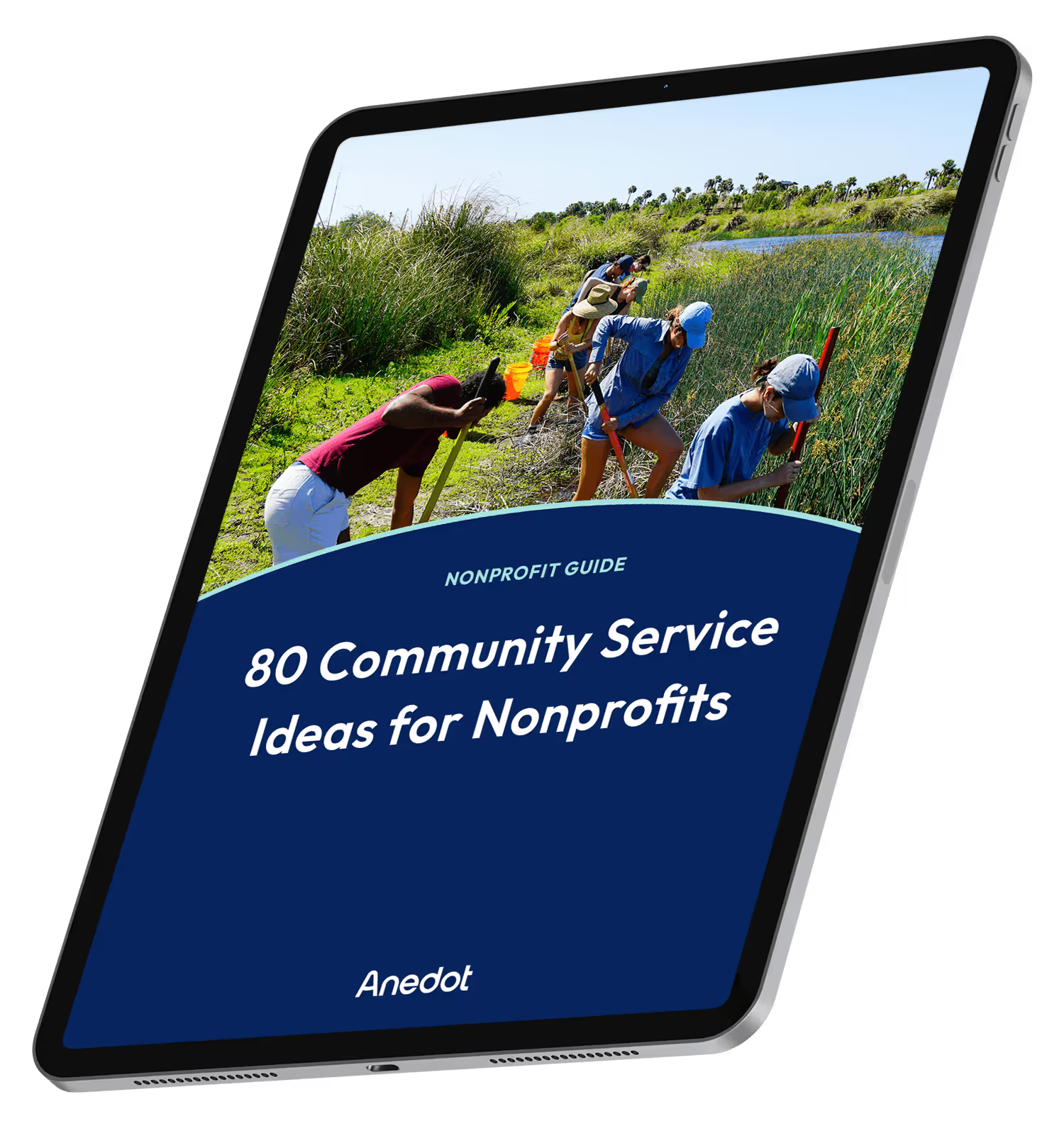
80 Community Service Ideas for Nonprofits
